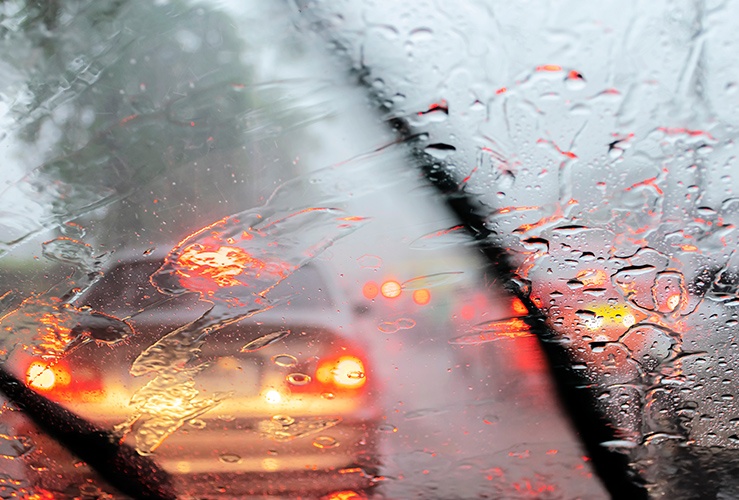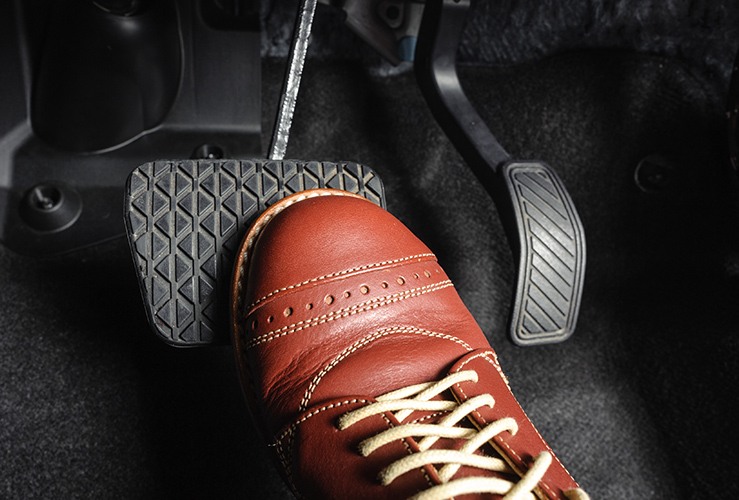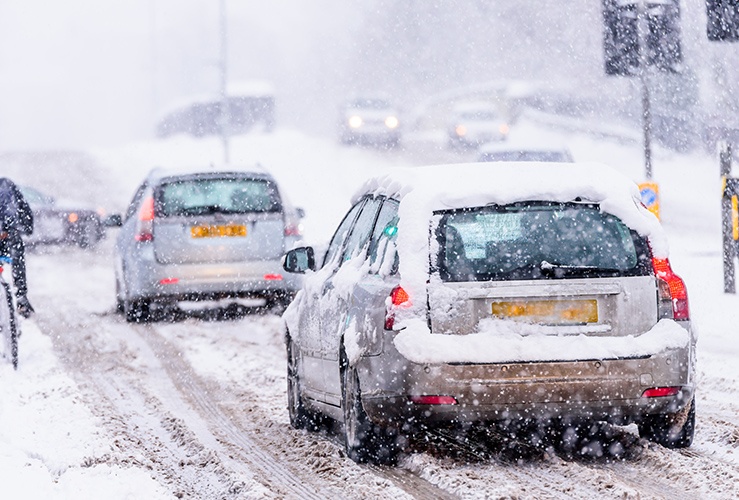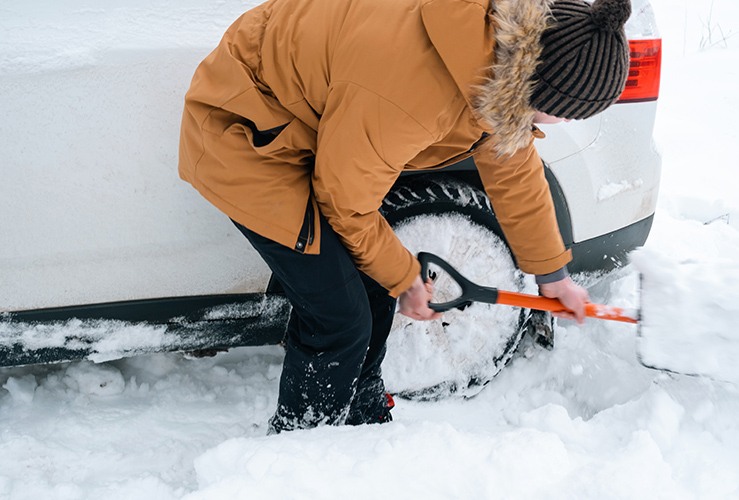Learn how to stay safe when driving in bad weather, with our guide.
Severe weather can greatly impact your ability to drive safely. Whether it's heavy rain, wind, snow, or even extreme heat - driving in inclement weather demands extra time and planning. And if the weather is very bad, it's worth asking: is it safe to drive right now? If it doesn't seem like safe driving weather, consider postponing your trip.
We've put together some useful tips for driving safely in severe weather.
Wet weather driving
When it comes to driving in the rain, it's important to start with the basics, however obvious they may sound. You should turn on your windscreen wipers as soon as rain begins to fall. If it's light rain, you can set the wipers to run at intervals of four seconds or so. Set them faster for heavier rain.
Your wipers will help keep the water droplets from obscuring your view.
To operate the front wipers, look for the button with a curved window and a wiper blade.
Use dipped headlamps with your wipers
It's good practice to turn on your dipped headlights alongside your wipers during daytime rain, to help other road users see you.
This is especially a good idea in dull, overcast conditions. Indeed, when driving in dull daytime weather in built-up areas, the Highway Code states that dipped headlights should be used.
And it goes without saying you are legally required to use headlights in the dark.
The symbol for dipped beam headlights is a headlamp shape with light beams angled slightly downwards.
Use rear wipers to clean the back window
You can turn on the rear wipers and the rear washer jet to clear your view. Rear windows tend to get spray from the road, which can make them dirty. It may not be necessary to leave the rear wipers running in lighter rain.
To operate the rear wipers, look for the button with a square window and a wiper blade.
Demist your windows
Get some warm air into your cabin to help clear any condensation. Look for the symbol of a sitting person with a heatwave rising over a curved window. This air conditioning function will help remove moisture from the air and prevent condensation from forming.
Another button, featuring a curved window covered by rising arrows, alongside the word 'MAX', can be used to direct air against the front and side windows.
Your car may also feature a button with a square window and waving rising arrows - this is for clearing the rear window.
Should you use the rear fog light in heavy rain on the motorway?
There's some debate on whether it's a good idea to use the rear fog light on the motorway in heavy rain. Using it will make you more visible to motorists behind you but may obscure your brake lights. Whether or not this is a good idea may depend on the arrangement of your rear lights.
But be sure to turn off the rear fog lamp when the rain eases off.
Take care when operating the pedals
If your shoes are wet, there's an increased chance of slipping on the pedals. With this in mind, take extra care and be more deliberate in your pedal action.
Reduce your speed, increase your stopping distance
It takes up to twice as long to stop in the rain compared to dry conditions. You should therefore keep your speed down and maintain a larger gap between you and the vehicle ahead.
When it comes to driving in bad weather of any sort, it's sensible to leave a bigger gap.
Take extra care on motorways and faster rural roads, where your speed will be higher; you'll need to ensure that safety gap is maintained at all times.
Hitting standing water at speed has far more of an impact than at lower speeds, so keep your speed down near puddles and try to avoid them if it is safe to do so.
Leave more time and be extra alert
Whenever there's rainfall, traffic will move more slowly. This goes double for heavy rain. You should therefore leave more time to reach your destination.
Travel at a pace you are comfortable with - one that gives you enough space and time to deal with any hazards that might appear.
Also be aware that not all drivers will behave sensibly - in both normal and bad weather. Make allowances for this behaviour but be ready to react to it as needed.
Aquaplaning
Aquaplaning occurs when you drive over standing water at speed. A layer of water forms between your tyres and the road, resulting in a loss of control.
How to deal with aquaplaning
Don't panic. Reduce your speed slightly and gently steer the vehicle in the direction you wish to go. Avoid any sudden moves - steering, acceleration, braking - since when you've passed through the puddle, you may have trouble maintaining control. Aquaplaning normally only lasts for a few seconds - so is only a temporary loss of control.
Avoid cruise control in heavy rain
Using cruise control in heavy rain could cause the wheels to spin up when they hit a puddle, resulting in a loss of control. As such, it's best to avoid cruise control in such conditions.
Ensure your tyres have up to 3mm of tread
The legal minimum tread depth is 1.6 mm. However, for extra grip and safety, it's advisable to have at least 3 mm of tread on each tyre. The deeper the tread depth, the less likely you are to aquaplane.
Deep water
When faced with a patch of deep water, keep your speed down (under 10mph) and aim for the shallow areas - if you can see them and if you can do so without blocking traffic coming the other way. The middle of the road is likely to be shallower, since it will be higher than the edges, where water should drain away.
Avoid driving through water if it rises past one third of your wheel. To judge depth, look at how high the water level is in relation to the kerb.
Driving through deep water could result in water entering your engine via the air intake or exhaust. Water can damage an engine beyond repair, so avoid deep water if you can.
Splashing pedestrians
In the UK it is illegal to splash pedestrians. You could get a fine if you are caught doing so. If there's a risk of splashing a pedestrian, keep your speed down and steer away from any puddles.
Icy, snowy road conditions
When it comes to challenging road conditions, snow and ice present some of the greatest risks. The following tips will help you reach your destinations safely.
Preparing your car
It is illegal to drive with snow on your vehicle, so make sure you remove it before you begin any journey.
You should also:
- De-ice and demist your windscreen
- Take lock de-icer for if you need to clear your lock
- Ensure the windscreen wipers are not frozen to the glass, or the fuse could blow
- Ensure your screen wash is topped up
Also pack:
Torch, hi-viz jacket to ensure you are visible if you break down, breakdown warning triangle, a blanket, snacks and drinks, de-icer, ice scraper, map, phone charger, first aid kit, and shovel with a piece of carpet that you can use if you get stuck in the snow.
Plan your route and leave more time
Stay up to date with weather reports and traffic news, and avoid any potential problem areas - such as one exposed to the elements.
Journeys in snowy or icy conditions are likely to take longer than usual, so allow more time to reach your destination. And if you are behind schedule, remember that it's better to be late than rush - which could increase the risk of skidding and loss of control.
Snowy road conditions: Safe driving tips
- Ensure your footwear is comfortable - and dry so you don't slip on the pedals
- Use sunglasses to reduce low winter sun glare
- Move off and accelerate gently, opt for lower revs and move into higher gears promptly
- Leave plenty of room between you and the vehicle ahead
- Keep your speed down, leave more time for steering - and stopping
- When going uphill, leave enough room ahead of you so you can maintain a steady speed - and so you don't need to change gear
- When going downhill, stay in a low gear, keep your speed steady, and maintain enough space between you and the vehicle ahead
- If you go into a skid, gently steer into it. Avoid taking your hands off the steering wheel and avoid the temptation to brake hard.
- Use your fog lights if visibility falls below 100m
- Note that wheel tracks can be icier than fresh snow - particularly if roads have not been gritted
Greatly reduced braking ability
In terms of skidding risk, snowy and icy conditions are considerably more dangerous than heavy rain.
To give an extreme example, a fully iced-over road would demand 10 times the stopping distance of a dry road. And of course, the faster you are travelling, the longer the distance required to stop.
Dramatically reduced cornering ability
Your ability to take corners on ice or snow is reduced to about the same degree as braking is. To take a corner in such conditions, keep your speed down and ease into the turn gently. If you feel your body weight lurch to the side, your speed and angle are probably too extreme.
Grip varies over ice and snow
Your level of grip will vary across a stretch of icy or snowy road because the covering will not be uniform. Be aware of this, and drive as if you have a very minimal level of grip throughout.
Do four-wheel drives handle ice better?
A four-wheel drive will be able to accelerate more effectively than a two-wheel drive on ice or snow, but cornering and braking will be equally challenging. As such, it's important not to feel overconfident when behind the wheel of a 4x4.
How to overcome a patch of snow in front of your tyres
If your vehicle has a patch or mound of snow in front of it, you may be able to overcome it by "rocking" your car.
To do this, lift your clutch to the bite point, which will push your tyres into the snow. Release the clutch, and the car will roll back a little. Repeat this process with a little more power each time, and you should eventually get over the obstructing snow.
Driving in strong wind
- Avoid driving in strong winds if you can
- Keep your speed down to reduce the impact of wind gusts
- Note that high-sided vehicles are more vulnerable on exposed roads
- Take care when overtaking high-sided vehicles
- Keep a firm grip on your steering wheel
- Allow more space for cyclists, motorcyclists, buses and lorries
Driving in extreme heat
With increasingly warm summers, it's worth knowing how to drive safely during heatwaves and higher temperatures in general.
- Know that reaction times can be longer in high temperatures
- Before setting off, let your cabin cool down by opening the doors for a while
- Getting into a hot car can leave you feeling disoriented or dizzy
- Use air conditioning to keep your cabin cool
- Wear breathable clothes to help stay cooler and more comfortable
- Don't wear flip-flops or any other open-toe shoes
- Stay hydrated
- Park in the shade
Ensure your tyres are properly inflated to avoid a blow-out









